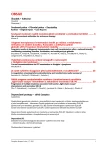Klener P.: Use of monoclonal antibodies for anticancer therapy
Authors:
P. Klener
Authors‘ workplace:
1. interní klinika 1. LFUK (VFN) a ÚHKT Praha
Published in:
Transfuze Hematol. dnes,17, 2011, No. 1, p. 6-11.
Category:
Comprehensive Reports, Original Papers, Case Reports
Overview
Monoclonal antibody-based therapeutic approaches have a significant impact in the treatment of hematologic malignancies and solid tumors. Rituximab in conjunction with chemotherapy is now standard treatment for follicular lymphoma, chronic lymphocytic leukemia and diffuse large B-cell lymphoma. Furthermore, based on our knowledge of antigen expression on the surface of lymphoma cells has led to development of the other monoclonal antibodies. Those, in clinical use or in clinical trials are shortly described. Similarly many monoclonal antibodies have been introduced for the treatment of solid tumors. These are directed against different targets such as growth factors (e.g. bevacizumab) or against the extracellular domain of epidermal growth factor (i.e. trastuzumab, cetuximab). For improving therapeutic efficacy, conjugated antibodies have been developed. Antibodies conjugated with radioisotopes (90Y), cytotoxic drugs (calicheamycin) or toxins (estafenatox) are used or are under investigation. Knowledge gained from molecular and cellular biology over past decades has driven the development of a new generation of monoclonal antibodies (bispecific/trifunctional antibodies, diabodies, peptibodies, intrabodies, immunocytokines).
Key words:
monoclonal antibodies, mechanism of action, monospecific antibodies, conjugated antibodies, bispecific antibodies, antibodies of new generation.
Sources
1. Adams GP, Weiner LM. Monoclonal antibody therapy of cancer. Nature Biotechnol 2005; 23: 1147-1157.
2. Klener P, Klener P jr. Nová protinádorová léčiva a léčebné strategie v onkologii Grada Publishing a.s. Praha, 2010.
3. Weiner LM, Surana R, Wang S. Monoclonal antibodies: versatile platforms for cancer immunotherapy. Natur Rev 2010; 10: 317-327.
4. Fanale MA, Younes A. Monoclonal antibodies in the treatment of non-Hodgkinęs lymphoma. Drugs 2007; 67: 333-350.
5. Belada D. Monoklonální protilátky v léčbě lymfomů. Remedia 2008; 6: 416.423
6. Castillo J, Winer E, Quinsberry O. Newer monoclonal antibodies for hematological malignancies. Exp Hematol 2008; 36: 755-768.
7. Wierda WG, Kipps TJ, Keatimg MJ, et al. Self-administered. subcutaneous alemtuzumab to treat residual disease in patients with chronic lymphocytic leukemia. Cancer 2011; 117: 116-124.
8. Khubchandani S, Czuczman MS, Hernandes-Ilizalituri FJ. Dacetuzumab, a humanized mAb against CD40 for the treatment of hematological malignancies. Curr Opin Invest Drugs 2009; 10: 579-598.
9. Palácová M. Trastuzumab. Remedia 2009; 20: 4-13.
10. Van Cutsem E. Cetuximab and chemotherapy as initial treatment for metastatic colorectal cancer New Engl J Med 2009; 369: 1408-1417.
11. Ellis LM, Hicklin DJ. VEGF-targeted therapy: mechanisms of antitumor activity. Cancer 2008; 8: 579-591.
12. Ricart AD, Tolcher AW, Liu G, et al. Volociximab, a chimeric monoclonal antibody that specifically binds alpha5beta1 integrin: a phase 1, pharmacokinetic, and biological correlative study. Clin Cancer Res 2008; 14: 7924-7929.
13. Leong S, Cohen RB, Gustavson GL, et al. Mapatumumab, an antibody targeting TRAIL-R1, in combination with paclitaxel and carboplatin in patients with advanced solid malignancies - results of a phase I and pharmacoklinetic study. J Clin Oncol 2009; 27: 4413-4421.
14. Lipton A, Goessi C. Clinical development of anti-RANKL therapies for treatment and prevention of bone metastasis. Bone 2011; 48: 96-99.
15. Chan AC, Carter PJ. Therapeutic antibodies for autoimmunity and inflammation. Nature rev 2010; 10: 301-316.
16. Weber J. Ipilmumab: controversies in its development, utility and autoimmune adverse events. Cancer Immunol Immunother 2009; 58: 823-830.
17. Carter PJ, Senter PD: Antibody-drug conjugates for cancer therapy. Cancer J 2008; 14: 154-169.
18. Cicone F, Russo E, Carpaneto A, et al. Follicular lymphoma at relapse after rituximab containing regimens: comparison of time to event intervals prior to and after (90)Y-ibritumomab-tiuxetan. Hematol Oncol 2010; (epub ahead of print).
19. Estey E. New drugs in acute myeloid leukemia. Semin Oncol 2008; 35: 439-448.
20. Lewis Phillips GD, Druger DL, Crocker LM. Targeting HER2-positive breast cancer with trastuzumab-DM1, an antibody-cytotoxic drug conjugate. Cancer Res 2008; 68: 9280-9290.
21. Younes A, Bartlett NL,Leonard JP, et al. Brentuximab vedotin (SGN-35) for relapsed CD-30-positive lymphomas. New Engl J Med 2010; 363: 1812-1821.
22. Forsberg G, Skartved NJM, Wallén-Ohman M, et al. Naptumomab estafenatox, an engineered antibody-superantigen fusion protein with low toxicity and reduced antigenicity. J Immunother 2010; 33: 492-499.
23. Kontermann RE. Recombinant bispecific antibodies for cancer. Acta pharmacol 2005; 26: 1-9.
24. Goldenbereg DM, Cardillo IM, Shi V, et al. Bispecific anti CF20/22 antibodies inhibit B-cell lymphoma proliferation by unique mechanism of action. Blood 2008; 111: 2211-2219.
25. Nelson AI, Reichert JM. Development trends for therapeutic antibody fragments. Nature Biotechnol 2009; 27: 331-337.
26. Reichert JM. Antibodies to watch in 2010. Mabs 2010; 2: 28-45.
27. Holden SA, Lan Y, Pardo AM, et al. Augmentation of antitumor activity of an antibody-interleukin 2 immunocytokine with chemotherapeutic agents. Clin Cancer Res 2001; 7: 2862-2869.
Labels
Haematology Internal medicine Clinical oncologyArticle was published in
Transfusion and Haematology Today

2011 Issue 1
Most read in this issue
- Klener P.: Use of monoclonal antibodies for anticancer therapy
- Samková A., Dulíček P., Pařízková E., Vokurka J.: Is coagulation screening before adenoidectomy and tonsillectomy really necessary?
- Brychtová Y., Krejčí M., Doubek M., Tomíška M., Navrátil M., Ráčil Z., Dvořáková D., Horký O., Lengerová M., Pospíšilová S., Mayer J.: Long-term results of allogeneic hematopoietic stem cell transplantation after a reduced-intensity conditioning busulfan, fludarabine, and antithymocyte globulin
- Pika T., Balcárková J., Lochman P., Minařík J., Jarošová M., Raida L., Bačovský J., Ščudla V.: Progression of multiple myeloma associated with partial „light-chain escape“ phenomenon and secondary t(8;14)
